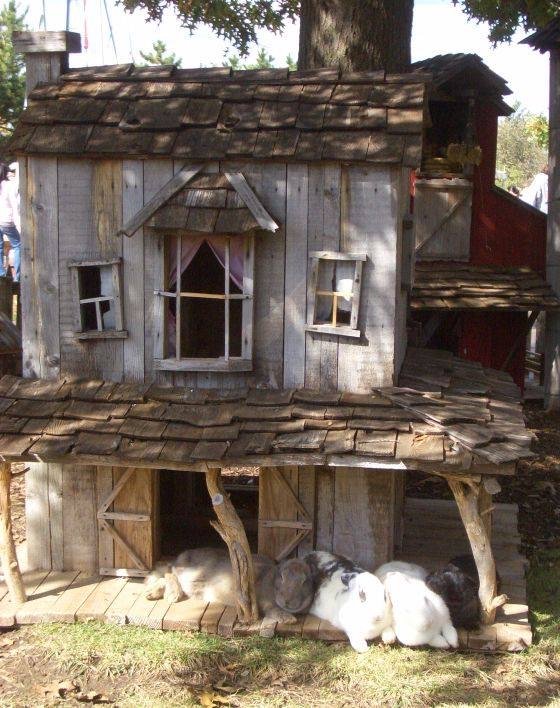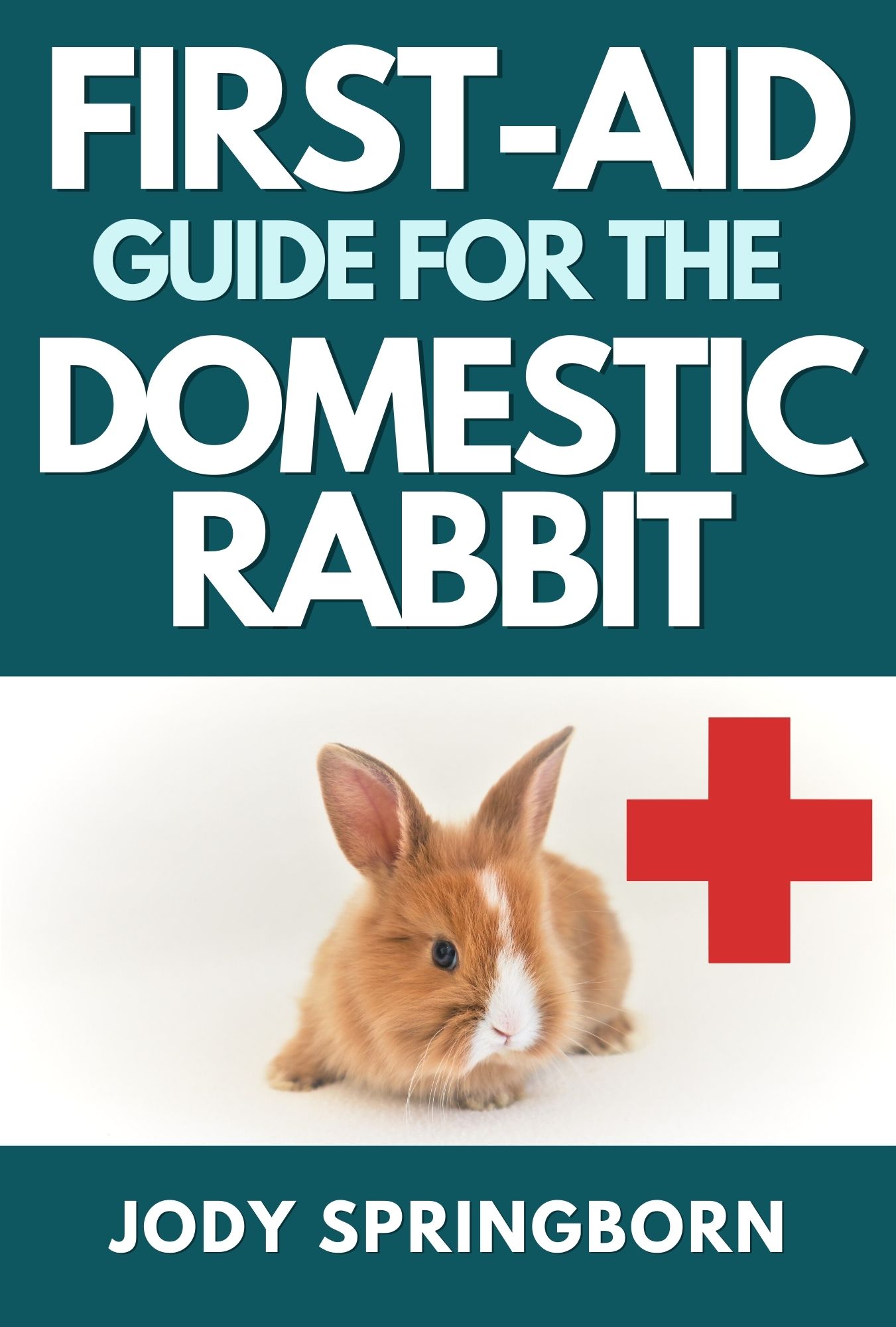- Home
- Rabbit Cages and other terrible ideas
Rabbit Cages
and Other Terrible Ideas
So My Roommate is This Rabbit...
Rabbit cages and hutches are one of the first things prospective owners think about purchasing for their new bunny. This is a terrible idea. Let’s go through the housing basics and learn why a cage and a hutch are not enough.
Traditionally, rabbits have been kept in a hutch or pen in the garden or barn. They were usually raised to be food and treated as livestock. Occasionally they were kept as pets, but usually people considered domestic rabbits as belonging in a farm, or maybe something like a "starter pet" - something to give to your kids to ease them into the concept of pet responsibility, before you got that dog or cat that everyone really wanted instead.
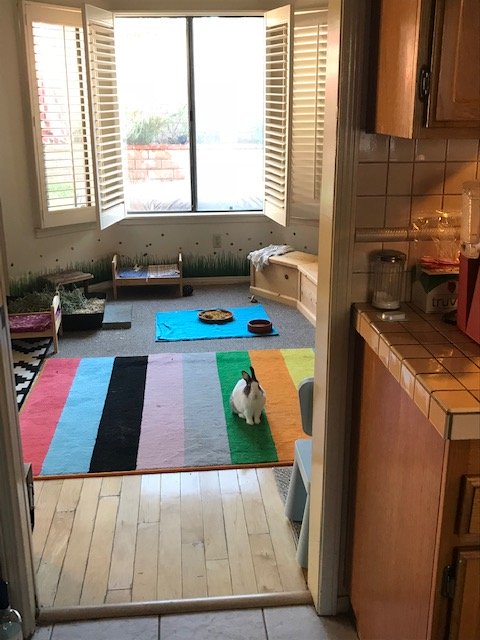 Houdini looking like the perfect hostess to greet you into her home. Photo by Food4Buns.
Houdini looking like the perfect hostess to greet you into her home. Photo by Food4Buns.However, in the mid-1980's, people slowly came around to the idea that rabbits are so much more than scared creatures sitting alone in a cage. Given the opportunity, they could become as engaging as any dog or cat, and the best way to experience that was to make them an integral part of your life. That meant getting rid of the cage and hutch, and letting the rabbits explore your home, giving them lots of toys and paying attention to them.
Many people have gotten creative with their rabbit set-ups. Some people have a big playpen area, while others have multi-story condos set up in the living room or bedroom. Some bunnies have the run of the house, where they lay by the patio door and soak up the sunshine.
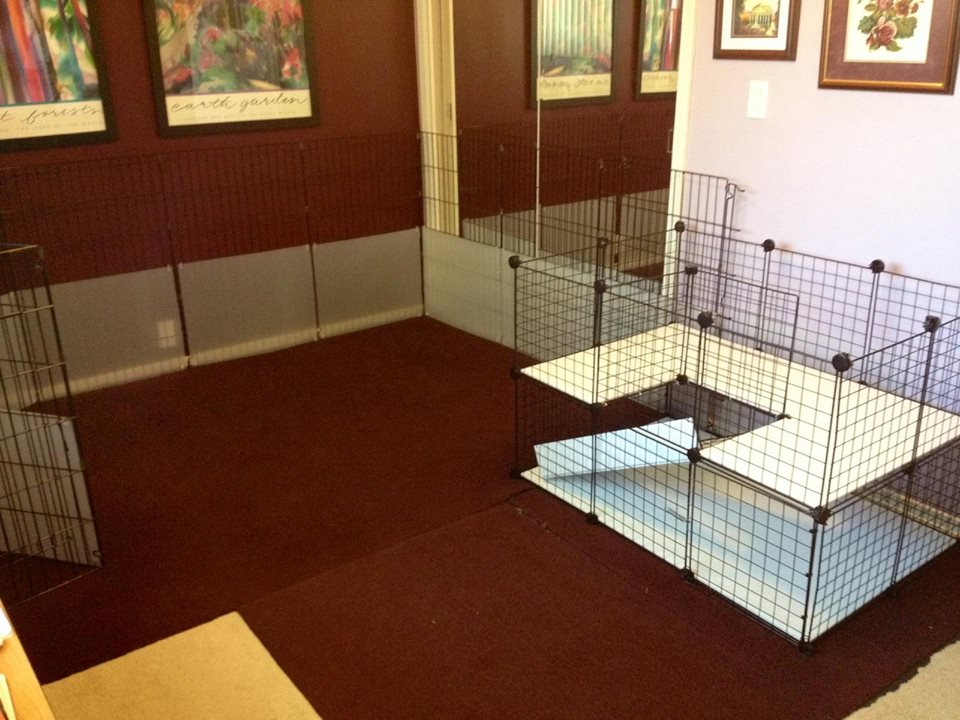 Two story condo sitting within a large 6x4 exercise pen. The condo is always open so bunnies can enter and leave whenever they want. Two story condo sitting within a large 6x4 exercise pen. The condo is always open so bunnies can enter and leave whenever they want. |
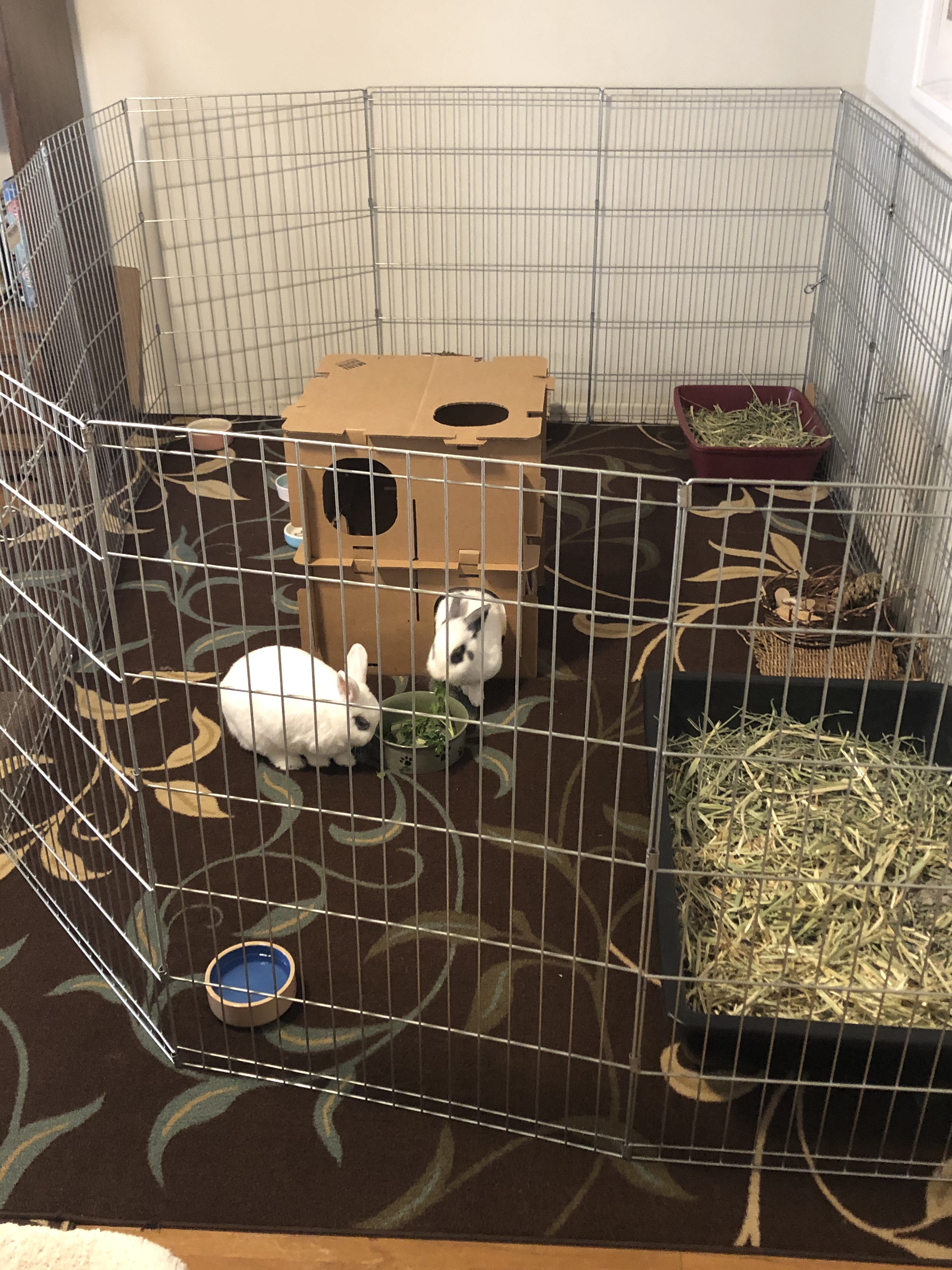 6x6 exercise pen in the living room. Photo courtesy Laura Lemmo. 6x6 exercise pen in the living room. Photo courtesy Laura Lemmo. |
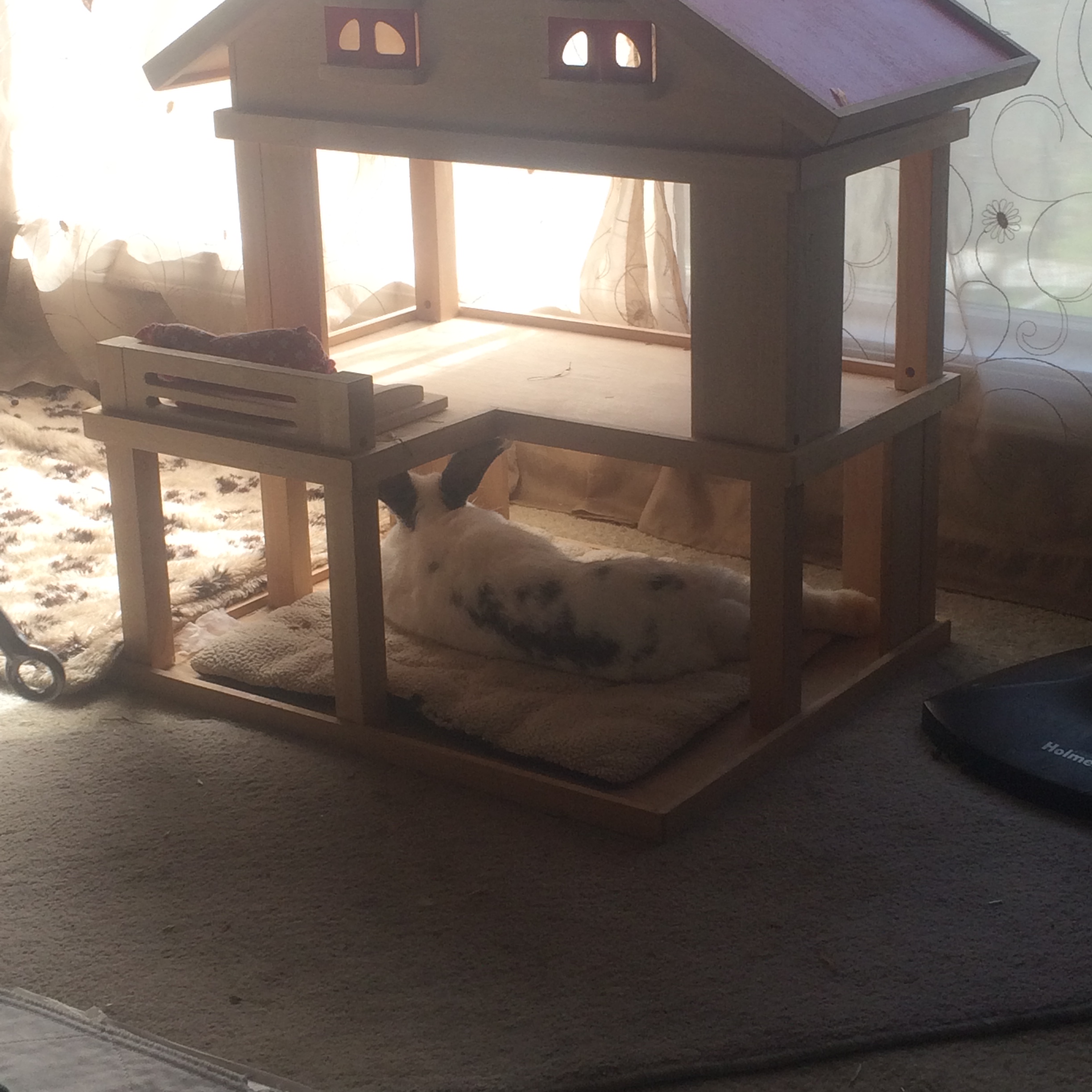 Nat sleeping in the afternoon sun.
Nat sleeping in the afternoon sun.Turn That Rabbit Cage into an Exercise Pen
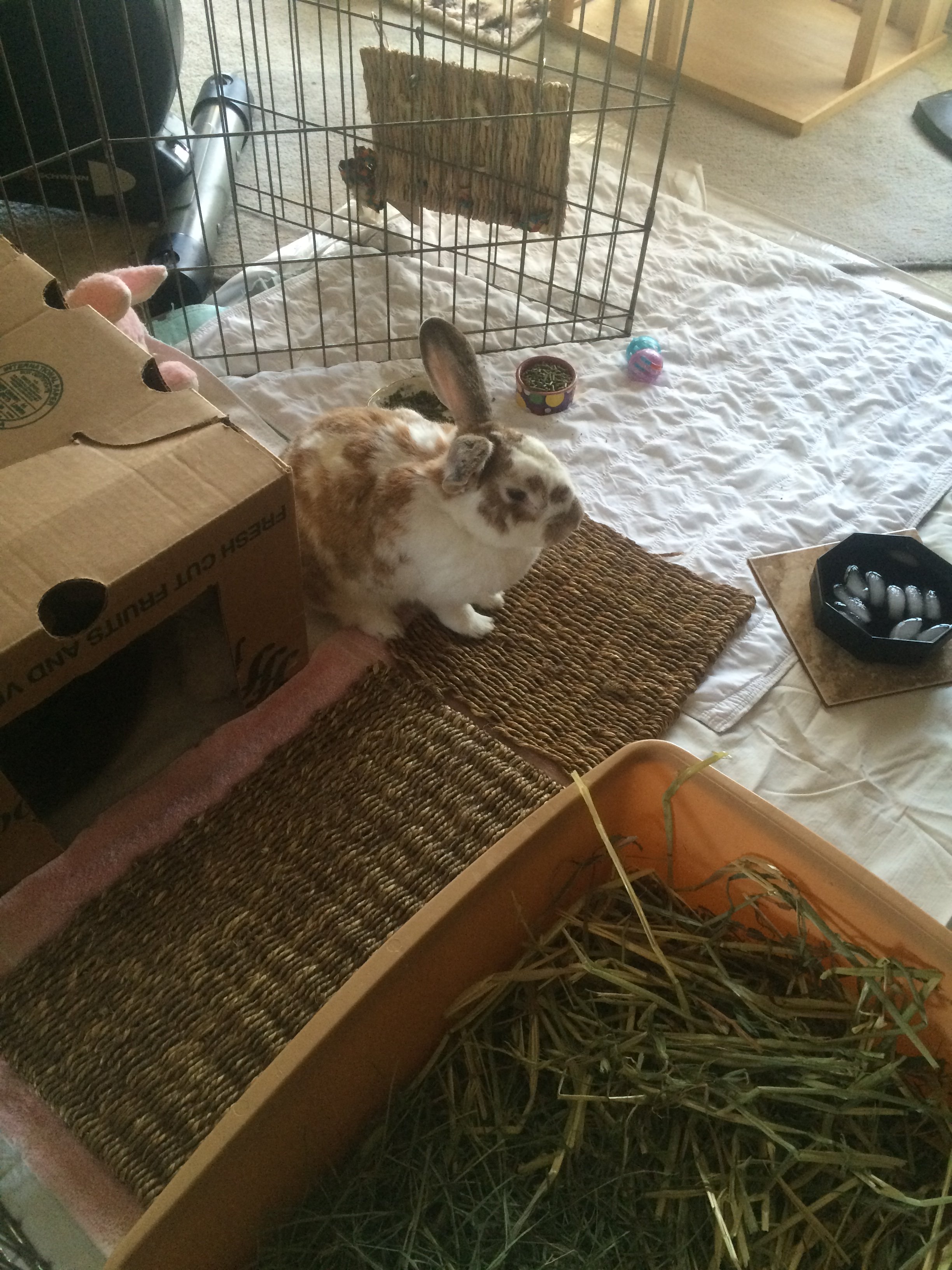 Benji is modeling his pen set up. It has all the things a spoiled bunny could want.
Benji is modeling his pen set up. It has all the things a spoiled bunny could want.The minimum enclosure for 1-2 rabbits (about 5-6 lbs) is a 4x4 exercise pen. This is big enough for a litter box, toys and food dishes. The rabbits are able to stand up, stretch out and hop around. Note: If you have one of the giant breeds, I would suggest you give them free range, a room of their own or, at the very minimum, a 10x6 exercise pen (or bigger). The more room you give a rabbit, the happier they will be.
Give some thought as to where you would like to place the pen. To make a bunny feel included in the family, I would place their home in the part of the house in which the bunny will interact the most with you. For many, this may be the living room, but not always. If you live with several roommates, the only choice may be the bedroom. This may also be the only choice if someone in the house suffers from allergies and you need to keep allergens to a minimum. I've met several people who keep their bunny in the kitchen. This depends on the layout of your kitchen, so this would not work for everyone. Others may house their bunnies in an home office or spare bedroom. Don't forget to bunny-proof!
Please note: Placing your bunny's living space in an active part of the house does not mean placing the pen in the loudest part of your home. If you entertain frequently or have small children, the noise and strange activity (particularly coming from strangers) may not be welcome. You may want the ability to shut the door to better isolate your rabbit for a short duration.
I've had several people in the past tell me that they house (or want to house) their bunny in a garage. Though many people in Southern California don't actually keep their cars in their garages, and re-purpose them to be another room in the house (albeit detached), there are a number of reasons why this is a bad place for a bunny. However, the main reason is the lack of insulation in the building. It's cold in the winter and brutally hot in the summer. This is no place to put a creature so sensitive to temperature (rabbits can get heatstroke at a temperature as low as 85F/29C). Additionally, unless you pretty much live in the garage, this is a lonely place to put a rabbit. Rabbits are social animals, so leaving the bunny to sit alone with only the family car and gardening supplies for company is cruel. If you actually keep your car in the garage, this is another compelling reason not to consider the garage. Blowing car exhaust in your rabbit's face is definitely not good for the rabbit's health.
Important! Despite an exercise pen, rabbits still need to have exercise outside of their pen, as well. They need approximately 4-5 hours of play time a day, so that may be the whole room instead of just a part of it or perhaps a room and a hallway, etc. Whatever you decide the play area should be, you will need to bunny-proof your home to protect both your belongings and the rabbit.
What about Outside?
There are many reasons why housing your bunnies outside is not a good idea. Read more here why so many experts advise owners to keep their bunny indoors.
Some people are able to provide fresh air without placing their bunny in danger. They may have an enclosed patio or balcony, or even sun-room. Regardless, there should be a second pen set-up inside in case of extreme temperatures. Also, be sure to bring them inside if your neighborhood has raccoons, coyotes or other predators who may attempt to break into your bunny's living space at night.
But It's a Big Rabbit Cage...
Rabbit cages and hutches, especially commercial ones, just aren't big enough to be primary living quarters. To illustrate, it would be the same if someone took a small child, placed him in the shower stall and said this would be his room for the rest of his life. That child may one day get transferred to the bathtub, or occasionally be let out to use the rest of the bathroom, but for the rest of the time, be confined in a very small space. Most people probably would say the shower stall or tub is too small for someone to live in permanently.
Important! I cannot stress enough the importance of space. I’ve had numerous experiences in which someone surrendered their rabbit because he was just “too mean.” The bunny would snarl or bite when anyone came too close. I experienced this at the city shelters when a bunny, who has been there for a long time, seemingly gave up hope. These rabbits will become aggressive and charge at anyone who approaches their cage or tries to engage with them. Part of the aggression has to do with the lack of spaying or neutering, but a large part of the aggression comes out of frustration - they are bored, scared and angry. They want out. They want to do something other than just sit around all day in a tiny space. If you give them a pen and introduce toys and a place to run around, they become much happier and much calmer. They are even inclined to love you. Give rabbits as much space as you can!
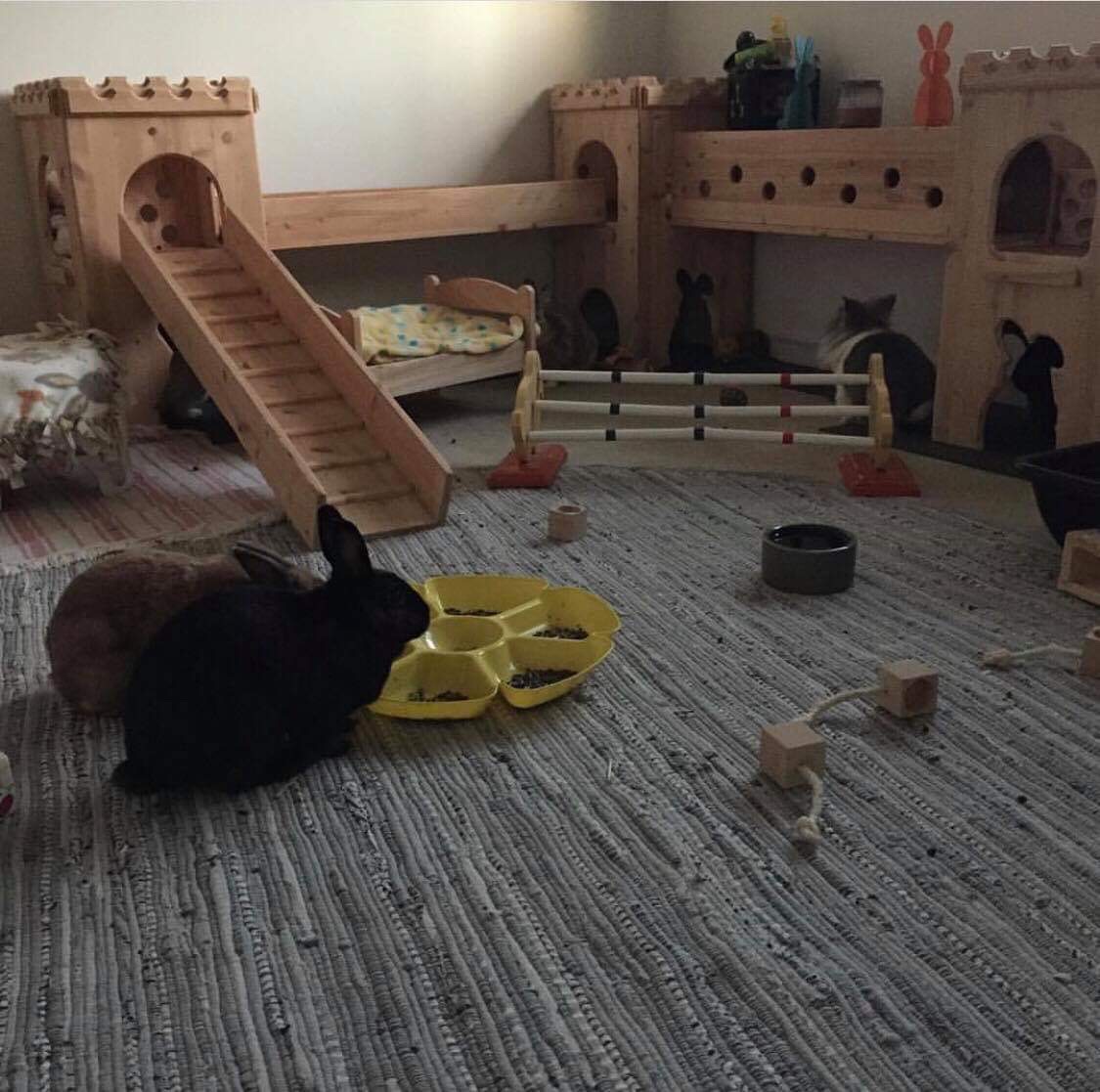 Some very spoiled bunnies enjoying their castle. Photo by Britta Menges.
Some very spoiled bunnies enjoying their castle. Photo by Britta Menges.
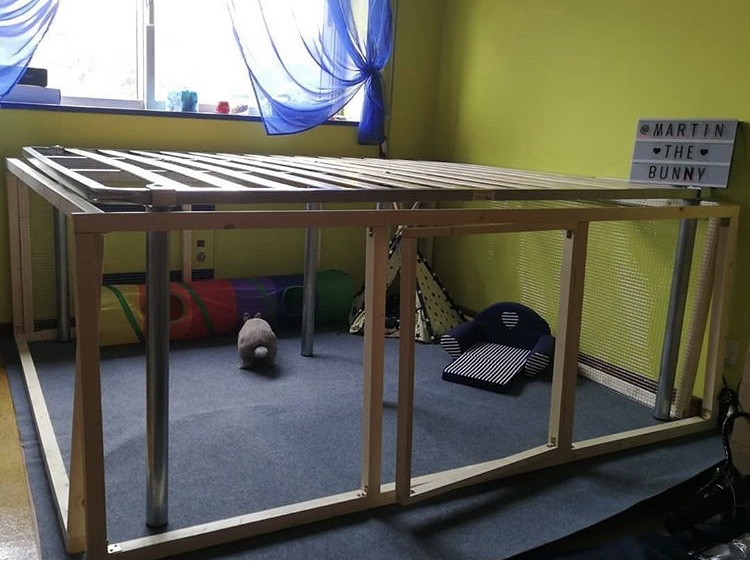 Even though Martin's owner lives in a small apartment in Viana do Castelo, Portugal, she wanted to give her bunny a big space. She came up with the solution of sharing her space with her bunny. The six metal supports are the base of the queen-size bed in which the pen sits underneath. Photos used with permission by Martin The Bunny. Even though Martin's owner lives in a small apartment in Viana do Castelo, Portugal, she wanted to give her bunny a big space. She came up with the solution of sharing her space with her bunny. The six metal supports are the base of the queen-size bed in which the pen sits underneath. Photos used with permission by Martin The Bunny. |
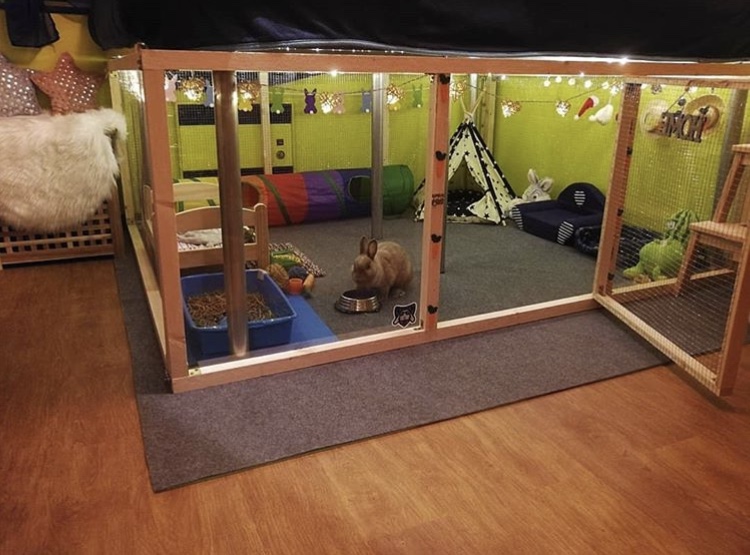 The pen is made out of wood and hardware cloth. Battery operated lights cover the top of the pen and there are various access points to enter. Obviously, Martin is also a very clean bunny. Photos used with permission by Martin The Bunny. The pen is made out of wood and hardware cloth. Battery operated lights cover the top of the pen and there are various access points to enter. Obviously, Martin is also a very clean bunny. Photos used with permission by Martin The Bunny. |
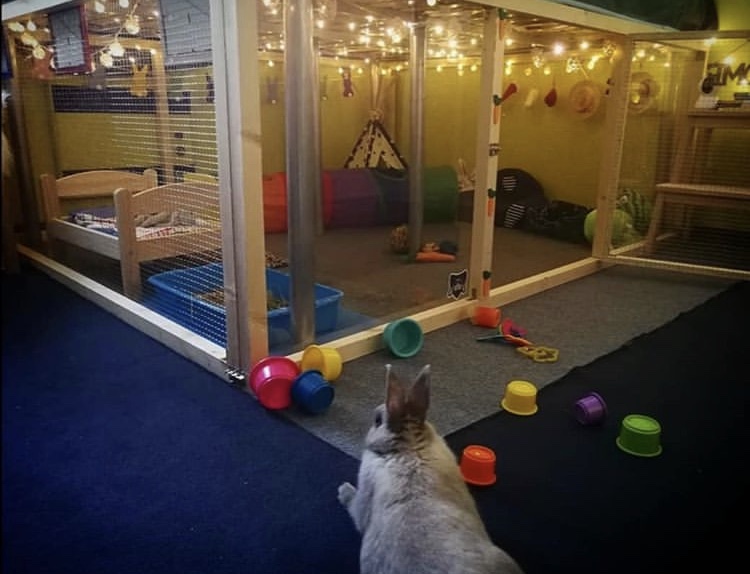 This is a great solution to a space problem. Martin looks very happy with his new area. Photos used with permission by Martin The Bunny. Follow Martin on Instagram (@martin_the_bunny).
This is a great solution to a space problem. Martin looks very happy with his new area. Photos used with permission by Martin The Bunny. Follow Martin on Instagram (@martin_the_bunny).What If I Already Have a Rabbit Cage?
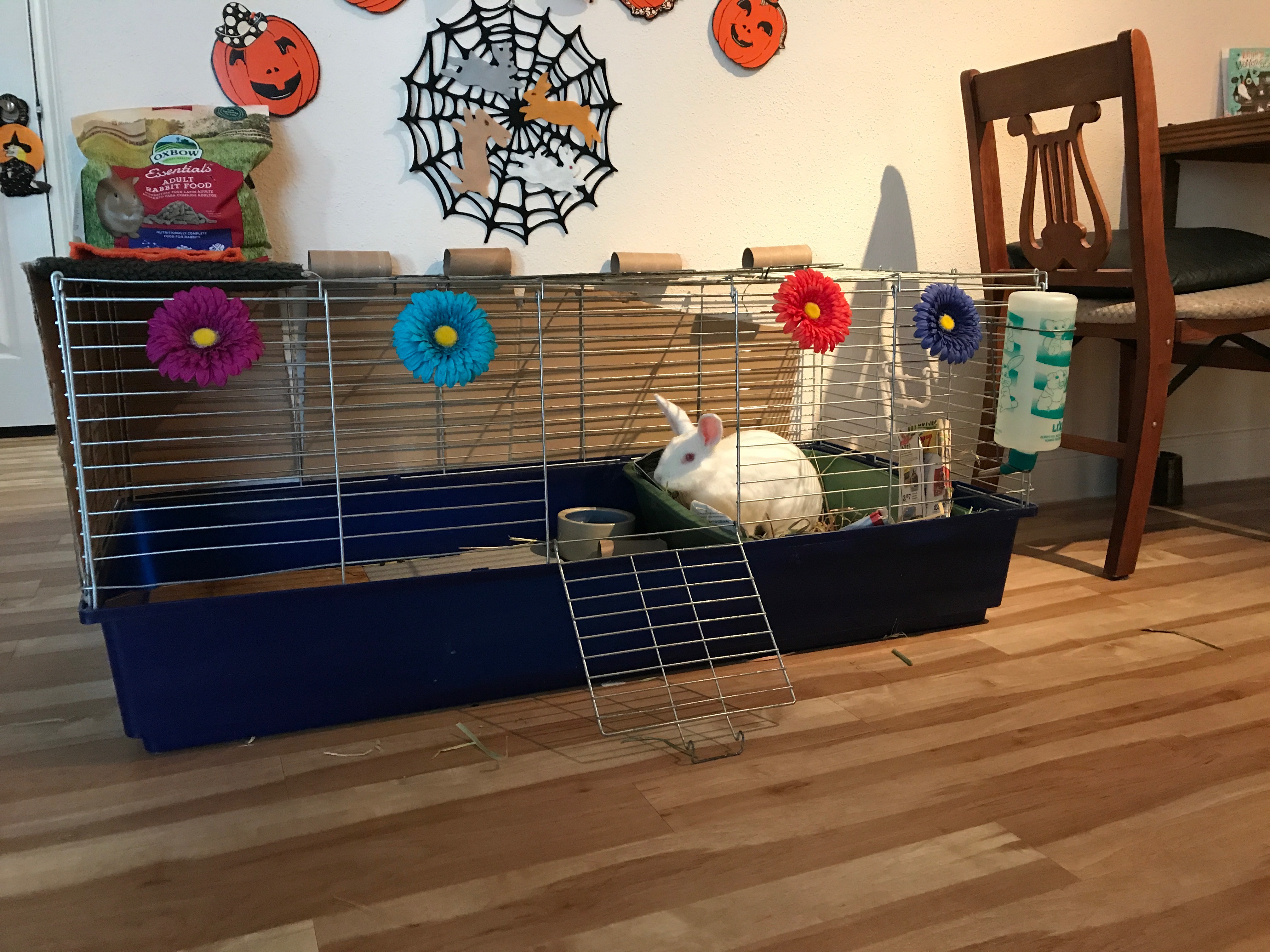 Ruby is getting a quick bite to eat before heading off to explore the apartment.
Ruby is getting a quick bite to eat before heading off to explore the apartment.Perhaps you've realized that rabbit cage Floppy has been living in for the last few months is not the right thing. Maybe you found this article after spending $300 on a hutch. What do you do?
Well, you can still incorporate it into your bunny's living space. Just as the shower stall in the previous example is an important (although not primary) element in your living space, so can the rabbit cage for your bunny.
The photo above shows Ruby in her cage. Ruby is primarily a free-range bunny, meaning she has full access to the apartment. The cage is only used to house the litter box and to be a place to sleep. It is also used for short confinement in those rare times her owners are away for several hours (apparently she has been known to ignore her toys and chew on the sofa instead). Overall, Ruby spends only a small part of the day inside her cage.
Important! Bird cages, fish tanks and terrariums should never be a part of a rabbit's housing set-up. These enclosures were never designed with a bunny in mind, and the use of them for a rabbit may result in the sickness or death of the bunny. This may be obvious for most people, but if you work in rescue long enough, you tend to see and hear of a lot of strange things.
Moving In
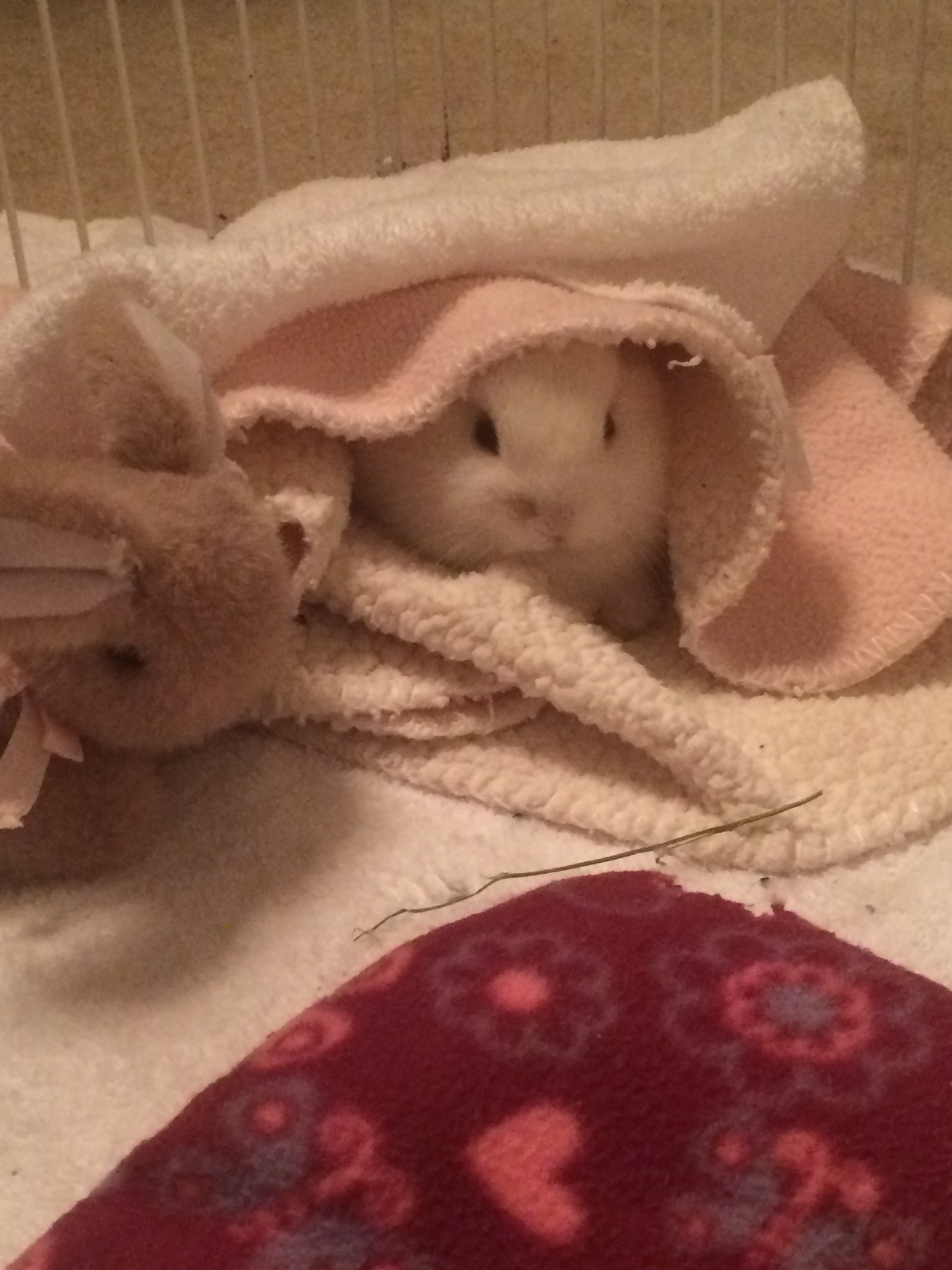 All bunnies, including babies, like to have a secure hideout. It can be as simple as burrowing in a blanket.
All bunnies, including babies, like to have a secure hideout. It can be as simple as burrowing in a blanket.So what goes into a rabbit pen? First and foremost, you want a litter box. Personally, I feel the bigger, the better (click here to read all about Litter Boxes and training rabbits to use them).
You also want to include a place to hide - a box with a side or two cut away is perfect! Some bunnies enjoy sitting on top of a box or stool - anywhere that lets them take in a view. However, most bunnies are not fussy. Even if you have a foot stool or chair, they will be happy to snooze underneath that. As long as there is some sort of 'roof' over their head.
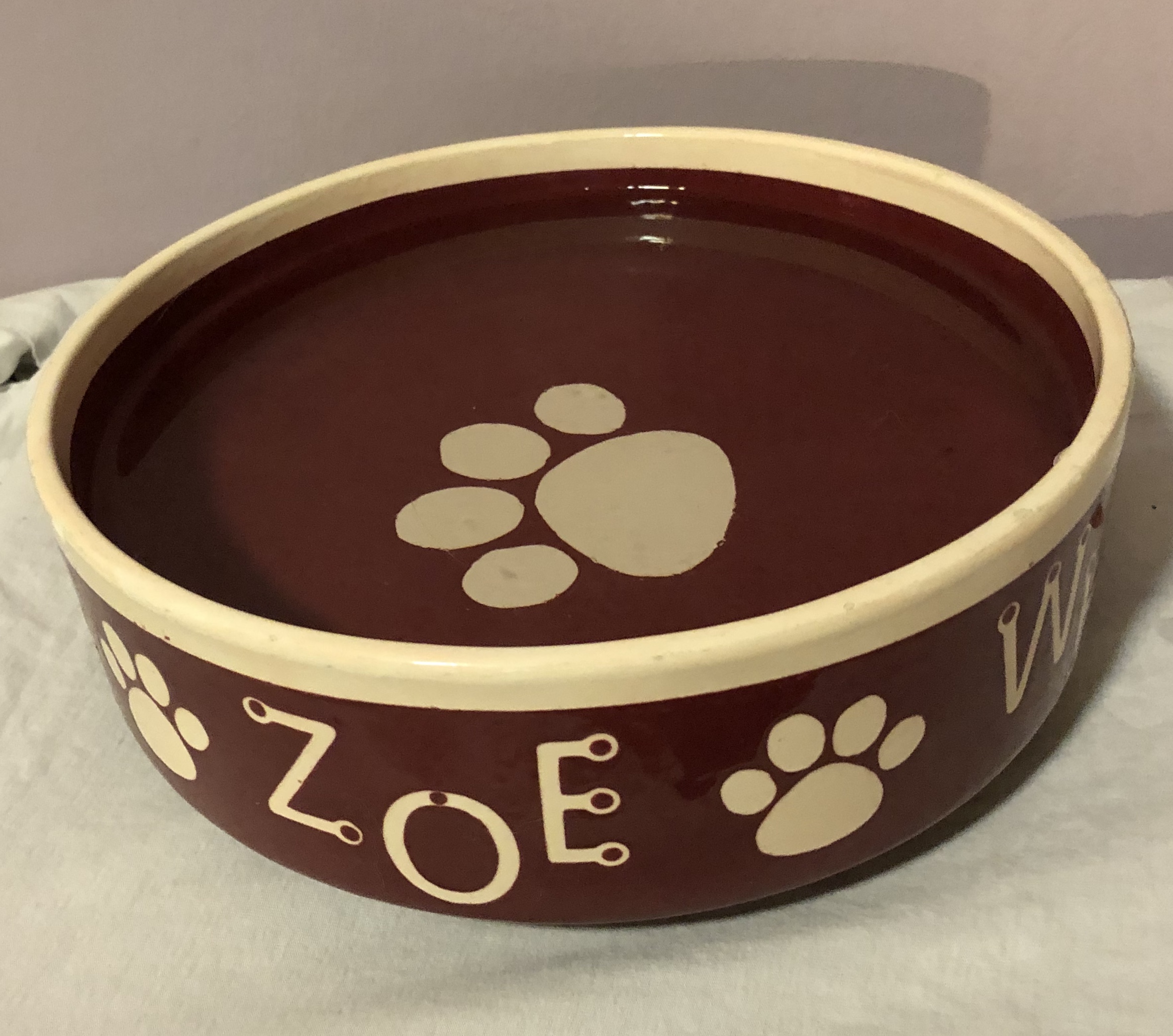 I recommend getting a heavy ceramic bowl usually sold in pet stores for bigger dogs. However, you can find retailers who can personalize a bowl with your favorite colors and bunny's name.
I recommend getting a heavy ceramic bowl usually sold in pet stores for bigger dogs. However, you can find retailers who can personalize a bowl with your favorite colors and bunny's name.You also need a heavy water bowl. I usually do not recommend the bottles you hang on cages, unless there is a special circumstance (such as a sick bunny who can't move around well). Bottles can be hazardous for a bunny and are much harder to clean. Although bunnies generally drink more from a bowl than a bottle, there are a few who prefer the bottle over bowl, or may want both. Make sure bowls (or bottles) are always filled and don't leak. Bowls need to be heavy, as bunnies like to throw around their food dishes, so a large ceramic bowl or a crock that can be attached to the pen itself is best. How big is 'big'? When I had a group of 4, I used a ceramic bowl that could hold 9 cups. That bowl wasn't going anywhere!
Last, but not least, you need some toys to keep your bunny entertained and engaged. Not every bunny likes the same toys, so pay attention to what your bunny loves to do. For more explanation and ideas, check out the Toys section.
